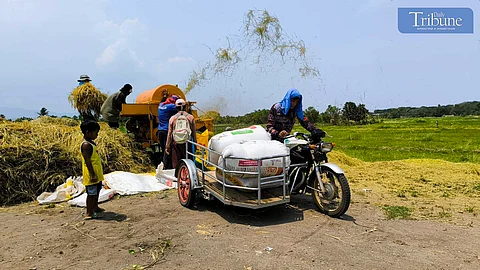
- NEWS
- the EDIT
- COMMENTARY
- BUSINESS
- LIFE
- SHOW
- ACTION
- GLOBAL GOALS
- SNAPS
- DYARYO TIRADA
- MORE

The Department of Agriculture (DA) faced criticism on Wednesday for setting the maximum suggested retail price (MSRP) of rice at P58, keeping the staple grain’s cost unreasonably high despite reduced tariffs and excess supply.
DA Undersecretary Asis Perez told the House Quinta Committee, which is investigating the high price of rice and other agricultural products, that the P58 MSRP was based on the landed cost of imported rice.
However, Agap Rep. Nicanor Briones criticized the MSRP as “unbelievable,” noting that tariffs had been reduced to P6.70 per kilo, world market prices had dropped by about P7, and farm gate prices had fallen to P3.
“We have plenty of stock. The former stock level of 60 became 80 days. It's clear that warehouses are full [rice stocks], but why isn't it being brought out to lower the price of rice? Because no one is catching them,” Briones said, accusing the DA and other agencies of failing to address price manipulation.
The Philippine Statistics Authority reported that the country’s total rice stock inventory reached 2.55 million metric tons in December 2024, a 34.5% increase compared to the same period in 2023.
Lawmakers argued that the oversupply of rice, along with Executive Order 62 enacted in July to cut rice import tariffs from 35% to 15%, should have led to flooded markets and lower prices. Iloilo Rep. Ferjenel Biron questioned why the DA used premium imported rice as the benchmark for the MSRP, noting that domestic rice accounts for 75% of national consumption.
“The contribution of imported rice is only one-fourth. Why do we use the price of imported rice to come up with the maximum SRP when the domestic price is cheaper?” Biron asked.
Biron also pointed out that pegging the MSRP based on imported rice prices compels importers to sell their products at higher rates. Perez acknowledged the concern, saying, “I agree that there must be a better way to address this and not just use [the] landed cost of imported rice as [the] basis for putting down MSRP, that’s true. But we are still working on the formula."
Biron lamented the delay in revising the formula, saying, “I don’t know how long will it take you to come up with a perfect formula while the Filipino people are all starving. You know, it’s an emergency. We can't feel that because we can buy rice but 26 percent of the Filipino population is considered poor."
The P58 MSRP, according to Perez, was part of a pilot program for Metro Manila, where rice prices reportedly range from P62 to P64 per kilo.
Briones attributed the persistent high prices to the DA and other agencies' failure to enforce the Anti-Agricultural Economic Sabotage Act, signed into law in late September to impose harsher penalties for smuggling, hoarding, and other large-scale operations inflating rice prices.
The law created a national council comprising multiple agencies, led by the President, to oversee enforcement. However, Briones lamented that nearly four months after the law took effect, the council had yet to become operational, and no culprits had been apprehended.
“It is clear to all of us that the consumer is being exploited, and yet no one has been apprehended,” he said.
The law classifies smuggling, hoarding, profiteering, and cartels as economic sabotage, punishable by life imprisonment and fines five times the value of smuggled or hoarded goods.
Lawmakers accused a “collusion” between rice importers and traders as the main driver of persistently high rice prices.
